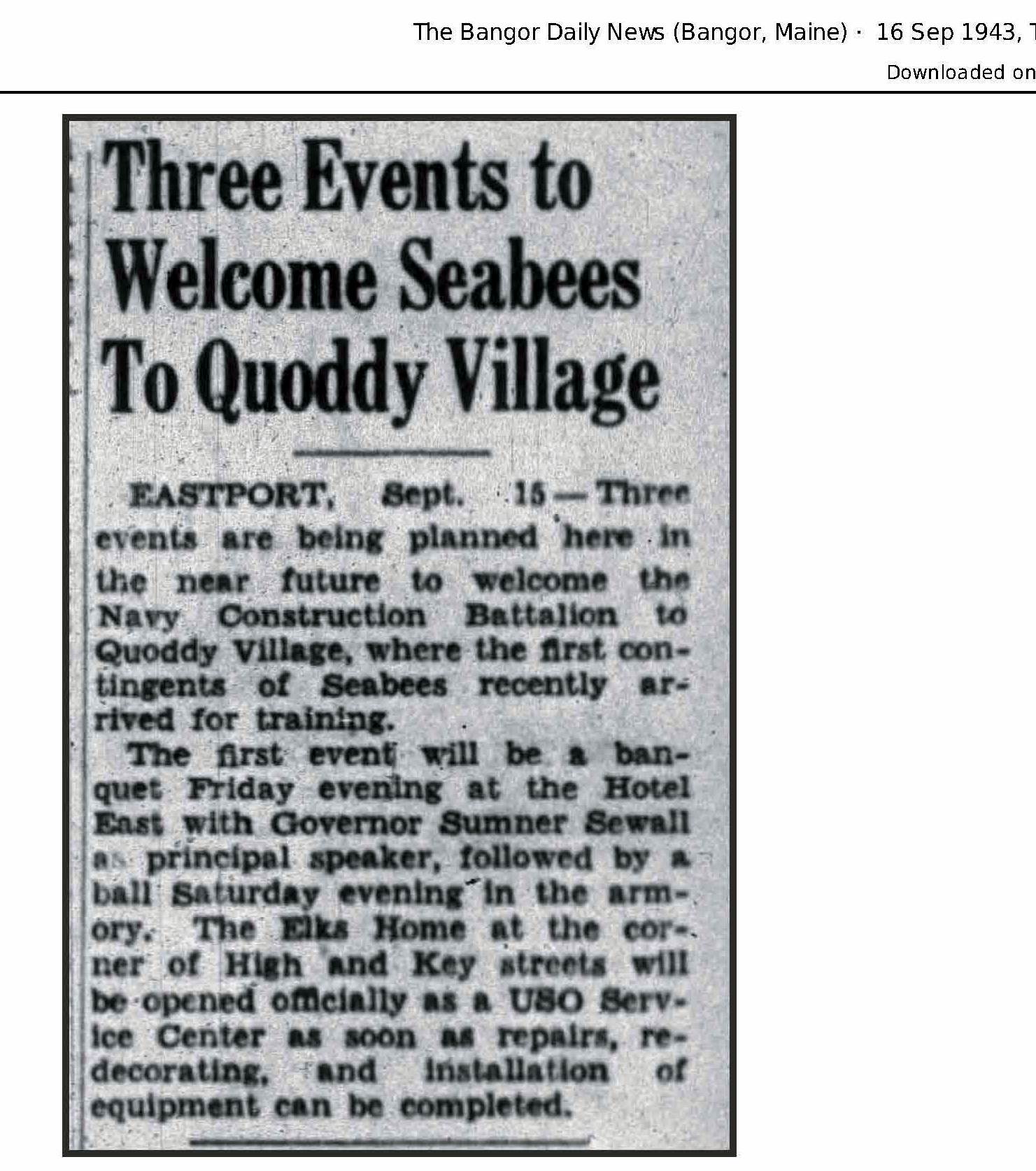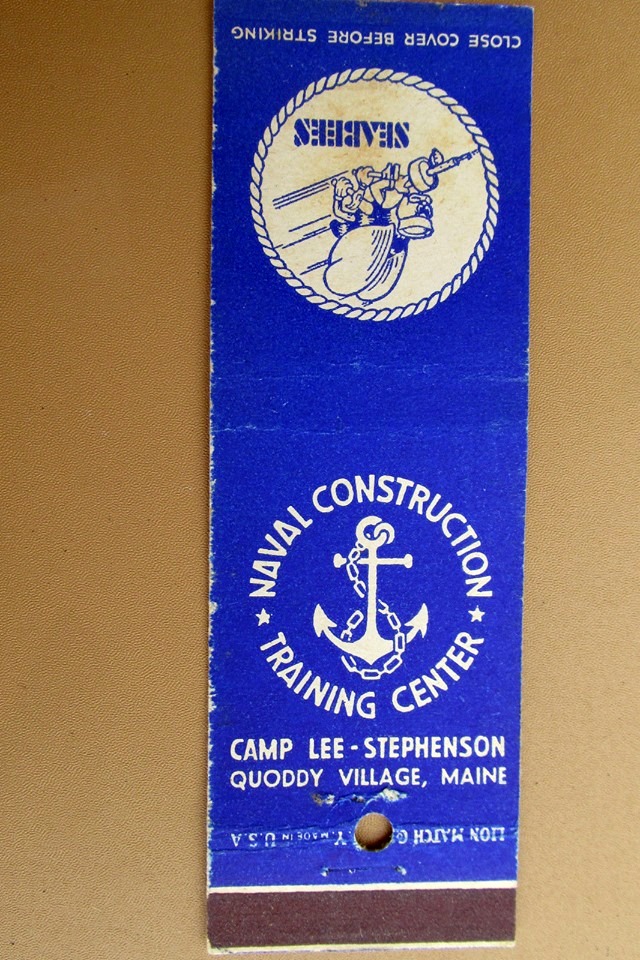
Match Book from 1943
Carol Allen, a loyal reader and contributor of valuable historical memories to the Historical Society asked recently for an article on the Seabees, the naval construction unit which trained in Quoddy Village in World War II. Good fortune has provided us with a first-hand account of the Seabees and their adventures and sometimes misadventures in the St. Croix Valley during their too short stay at Quoddy. First a bit of history.
Most who lived through the forties do not remember them with any fondness. One Calais history but it succinctly- “The forties were mostly tragedy for Calais.” They were even more tragic for our cousins across the river whose sons had been arriving home in caskets draped in Canadian flag for years before the United States entered the war. Further there were shortages of everything- clothing and food; fuel and tires for cars which even then were only allowed on the road for essential travel. The list was endless. Rations cards for what had in the past been considered essential were hoarded for special occasions. The economy was in a sad state, nearly all the young men were in the service and the stores, restaurants and bars were largely empty.
Life in the valley was somewhat monotonous until September 1943 when thousands of Seabees began to arrive for training at Quoddy Village, the then nearly deserted site of the abandoned Quoddy Tidal Power Project. Renamed Camp Lee-Stephenson after the first two Seabees to die during the war in the Pacific, thousands more would be stationed at the base until nearly the end of the war.
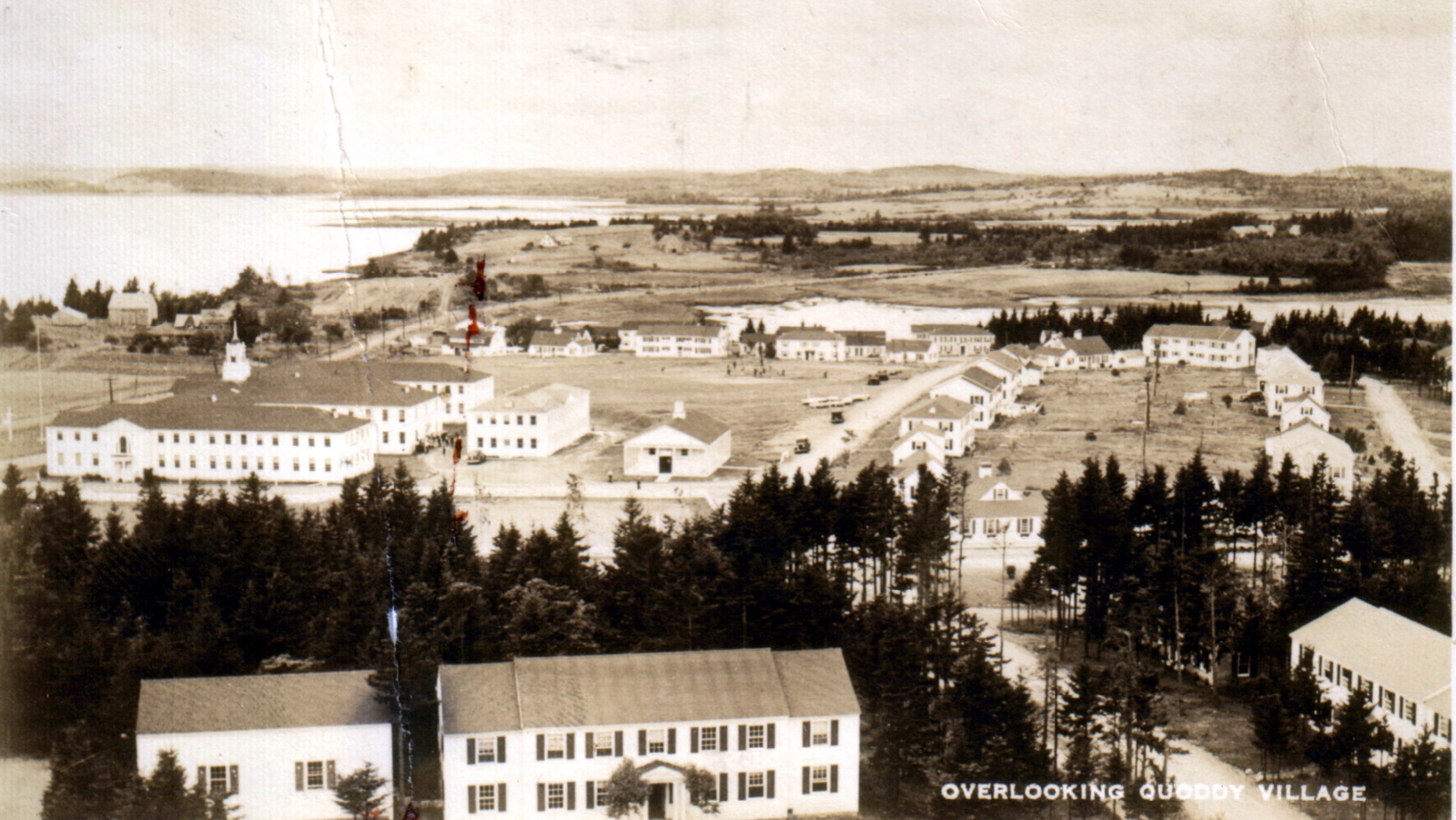
Camp Lee-Stevenson Quoddy Village
While Eastport offered some R and R facilities and recreational opportunities to the Seabees it could not compare to those offered in Calais and St. Stephen which was already hosting the RAF flyers training in Pennfield New Brunswick. Eastport and Pennfield are about equidistant from Calais/St. Stephen and hundreds, sometimes thousands of Seabees and RAF flyers began to converge on the two cities on any given day. They were a lively crowd with money in their pockets and the merchants were ecstatic. Busses and fleets of taxis began running on a regular basis to and from the bases.
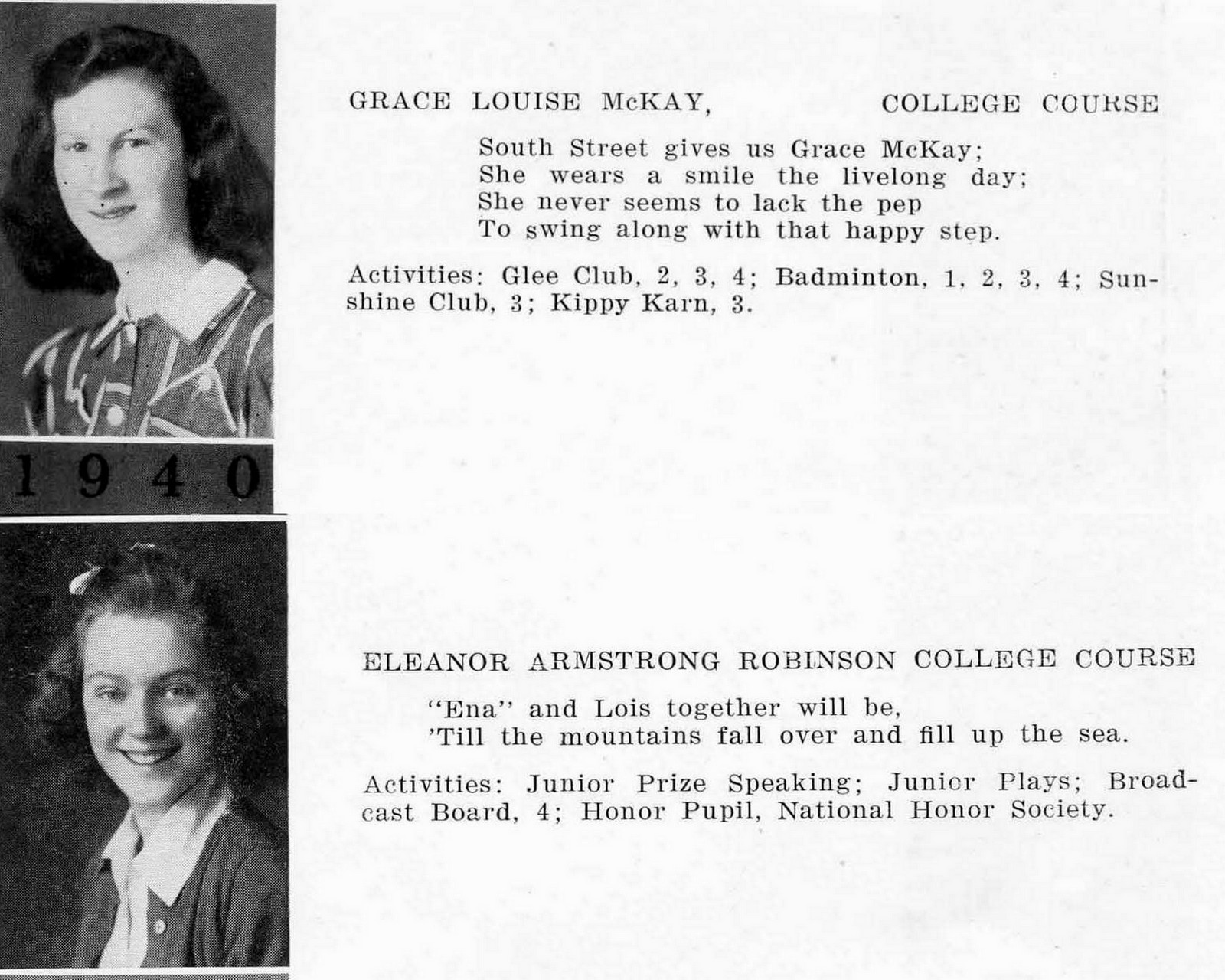
Ellie Robinson Nixon and Grace McKay Meader Class of 1941
Two young women from the Calais High Class of 1941, both lifelong residents of Calais, remember the invasion of the flyers and Seabees well.
A BIT OF HISTORY
By Eleanor Robinson Nixon and Grace McKay Meader
Late summer of 1943 and the second year of WWII—service men from RAF Base, Pennfield, New Brunswick were a familiar sight on the streets of Calais. Many local men and women were home on leave from military service. The NYA (National Youth Act) vacated Quoddy Village and rumors circulated that the Navy would be taking over the premises for Seabees.
Early September, four young ladies took the train from Calais headed for a vacation in Boston. They were shunted onto a siding at Ayers Junction and shortly after a trainload of Seabees went by on the main track headed east. Eleanor exclaimed “We’re headed in the wrong direction!”
Late summer many of the 1300 Seabees now stationed at Quoddy could be seen on our streets every evening. Members of the shore patrol were in evidence to help keep order. It was reported that three more battalions would report to Quoddy as soon as accommodations were available. This would bring the total up to around 4600.
The Elks building in Eastport was converted into a USO center and an official welcome of the Seabees to Quoddy Village was extended by the town.
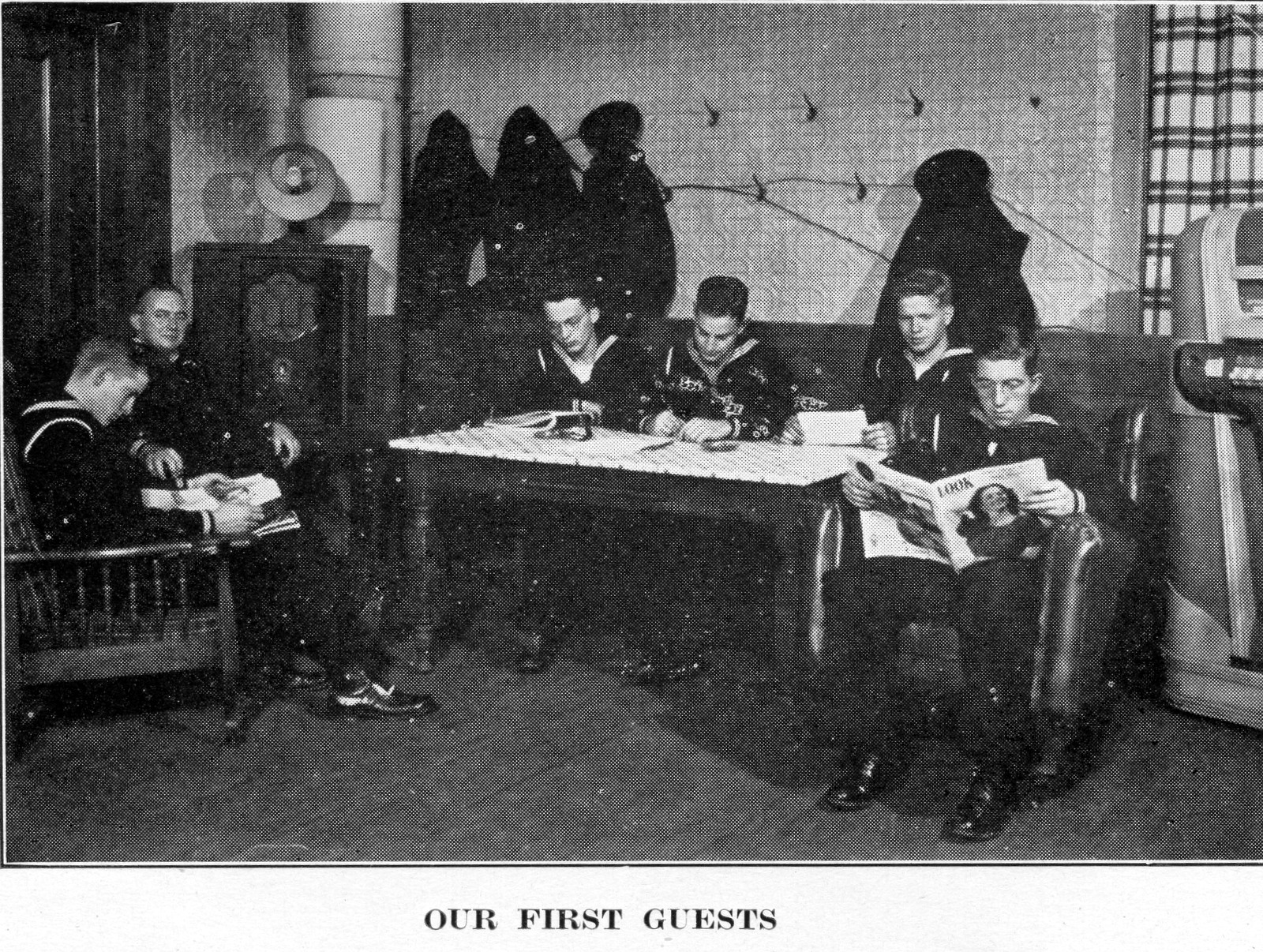
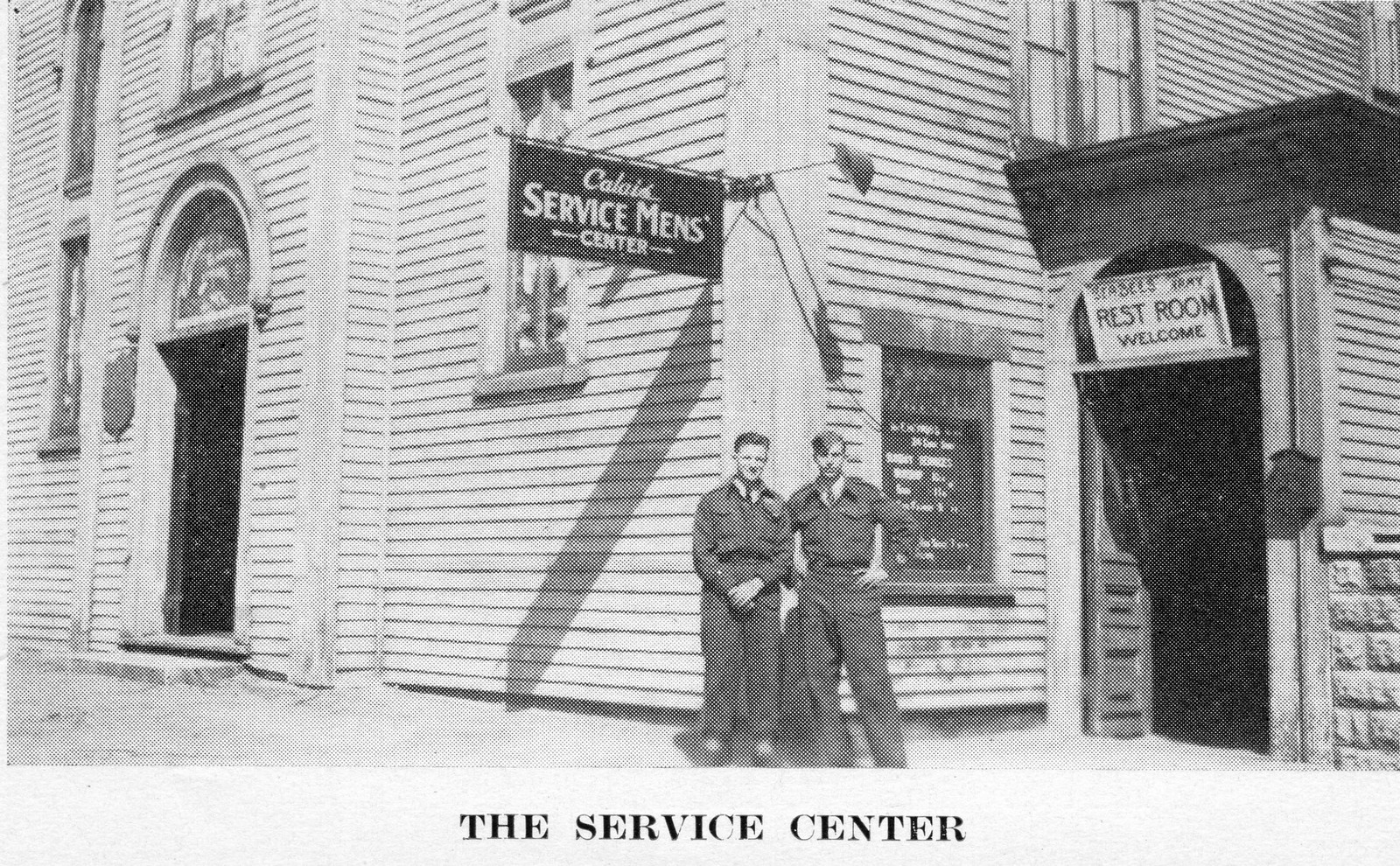
In Calais the service center was om Main St. just across from the bottom of Monroe Street. It was demolished in the early 50s.
Rev. Ernest Heywood, guided by remembrance of his own experiences in WWI, suggested the central location of the Methodist Church on Main Street in the heart of the city made it ideal for a service center for the men of the armed services who visit Calais. The church offered the space and heating and appealed for assistance from the community. A quick response in contributions of easy chairs, reading lamps, cots, and a ping-pong table allowed the center to open by early October, staffed by volunteers and was an immediate success.
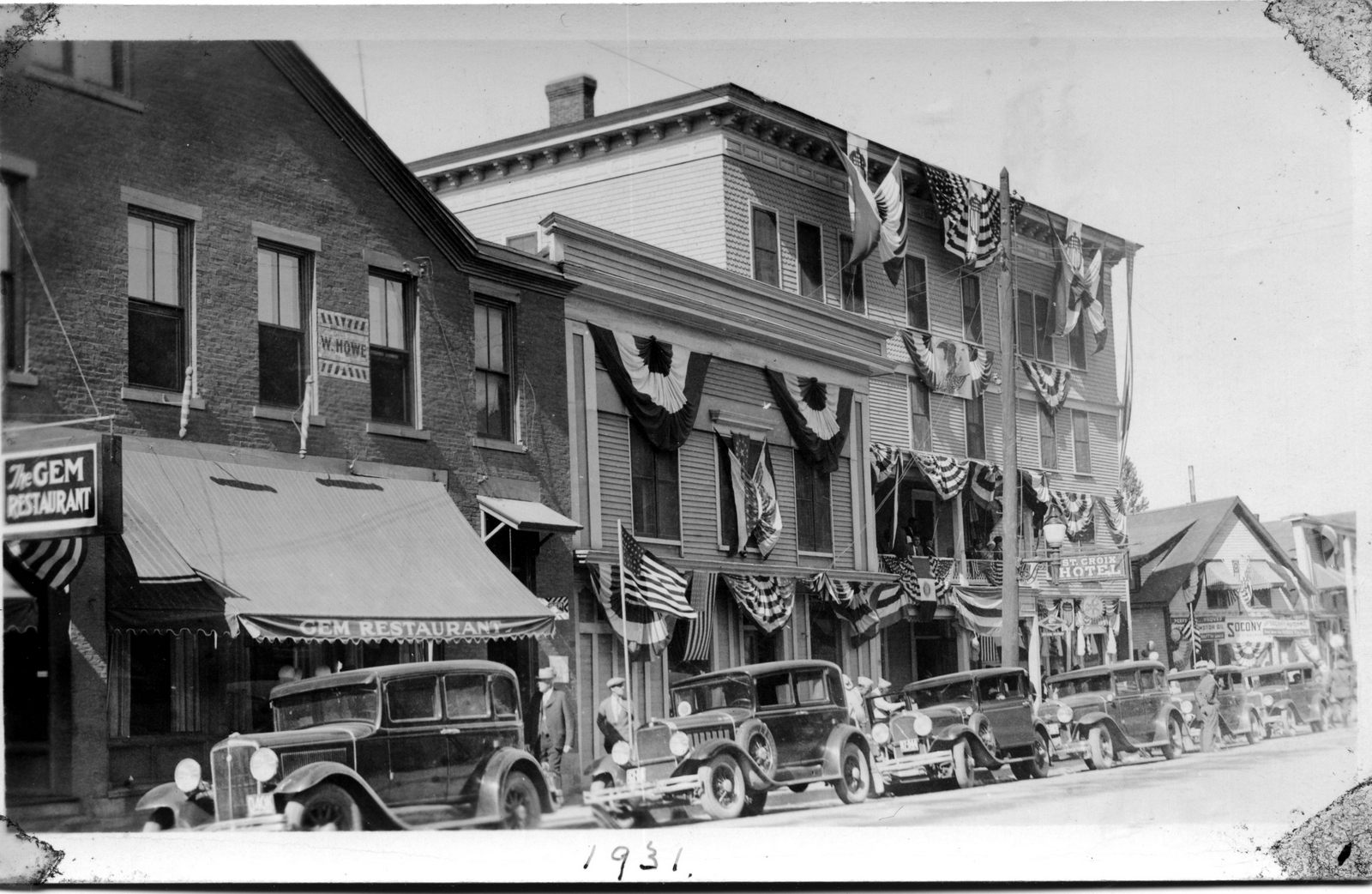
The Gem in 1931, St Croix Hotel to the right. It was a favorite of the flyers and Seabees.
The Gem Restaurant reported they were overwhelmed by the pressure of hundreds of Seabees in town every day, with long hours and not enough help available. They closed down for two weeks to allow their staff to recover from sheer exhaustion.
Over 1000 more Seabees had arrived at Quoddy on two special trains bringing the numbers to 2500 currently training at the village and another battalion or two were due to arrive in the near future.
By the middle of October, to supplement the overtaxed facilities of the Border Transportation Co., the Navy brought in buses to transport the Seabees from the base to Eastport and Calais.
Chaperoned by Mrs. Clarence Beckett, 35 local girls went to Eastport to attend a dance at Shead Memorial High School given for the Seabees. It alerted Calais they would have to provide means of entertainment for the visitors to our city.
Near the end of October Seabee officers were guests of the Calais Rotary Club and were told 4000 Seabees were expected to be in residence at the base in the near future.
A dance held in the Calais gymnasium on Tuesday night sponsored by the newly organized Calais USO proved to be a very pleasant affair. Excellent music was furnished by the 112th Battalion Orchestra who was right in the groove for this event. This is one of the top bands in the Seabee organization under the leadership of Jack Kelley (Y1C) and featured an outstanding singer. Hostesses for the affair were Mrs. Frances Beckett, Mrs. Marion Densmore, Mrs. Mary Peterson, Mrs. Helen Gay and Miss E. Lou Hill.
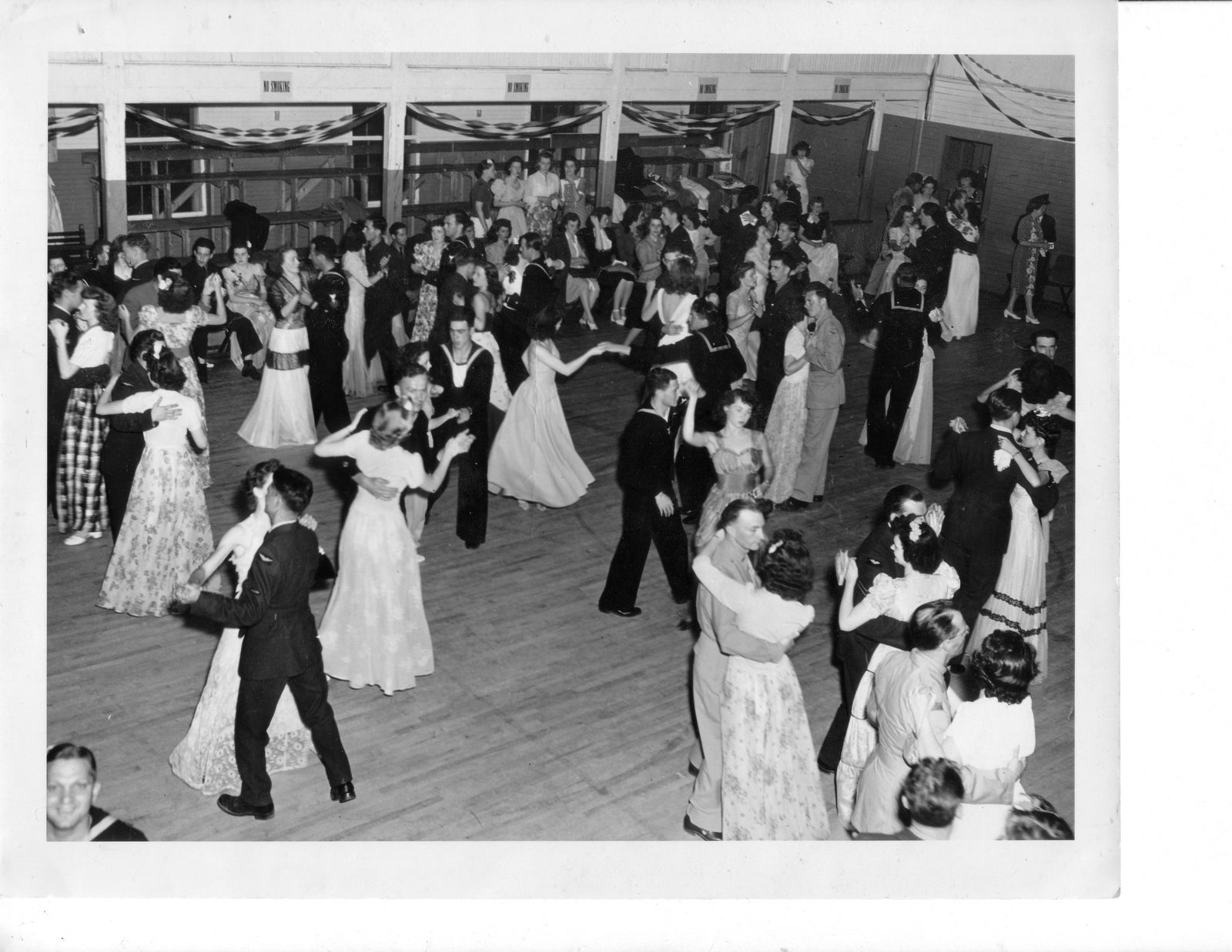
One of many USO dances at the Academy Street Gym
This set the pattern for Tuesday night dances at the gym each week. A special formal dance was held once a month, sponsored in November by the Women’s City Club, with jitterbug music by the 119th Battalion Orchestra. The 112th Battalion had shipped out. The formal in December was sponsored by the wives of the Rotary Club members. A Christmas tree decorated the hall and Santa distributed chocolate bars to our guests.
The USO was invited to a Christmas dance on Thursday, December 23rd at Quoddy, now renamed Camp Lee-Stephenson. 33 girls plus chaperones attended. The 119th Battalion had left, and music was by the 103rd Battalion Orchestra.
The Thursday night dances became a weekly event and we caught a Border Transportation Co. bus on North Street. We became accustomed to the sight of Lois flying down the street to hold the bus while sister Jean calmly strolled behind, knowing we would never leave without her. The trip down river didn’t seem long as our girls touched up their nail polish and singing of all the latest hit songs echoed through the bus. We were carefully escorted directly to the door for the dance and back again to the bus. One exception remembered was the wedding of a USO girl and a Seabee in the camp chapel. Several friends were allowed to attend the ceremony, wave the happy couple off on their trip and then rejoin the group for the dance.
The USO was permitted the use of the Legion Hall on Lowell Street as a drop-in center for small dances on the second floor.
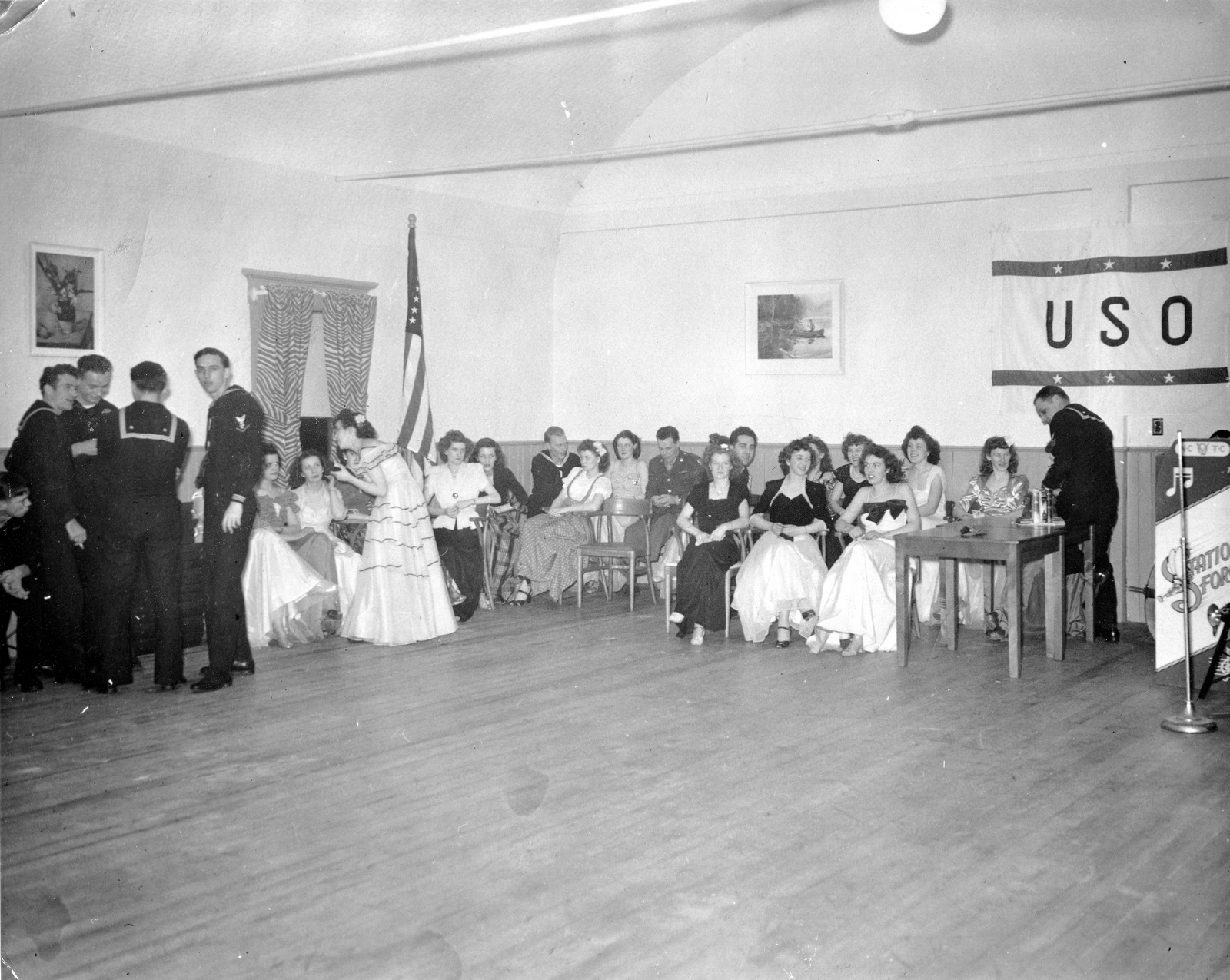
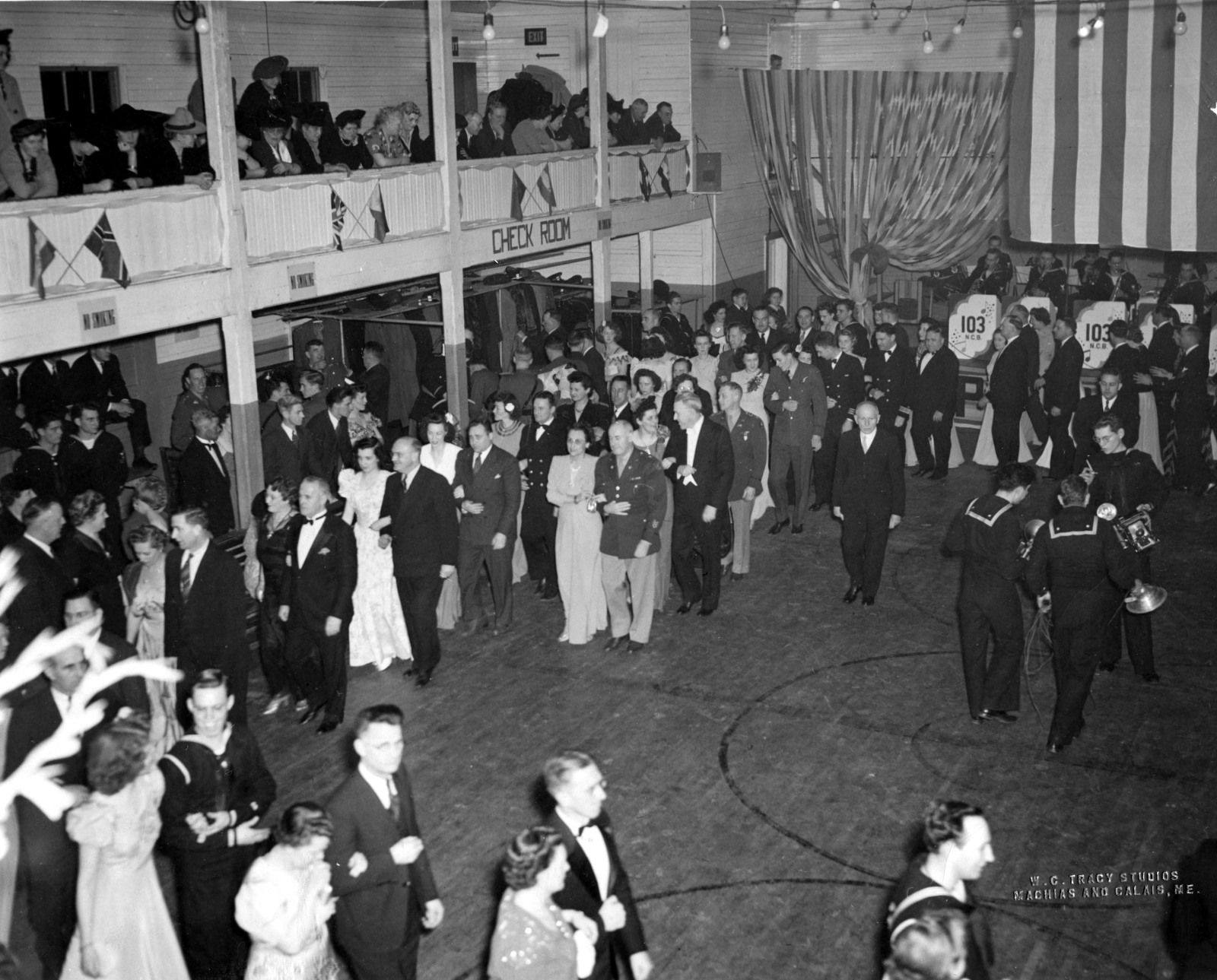
President’s Ball Academy Street Gym
January 1944, the President’s Birthday Ball was a special event with Arthur Unobskey, chairman. The USO was invited along with distinguished representatives of Maine and New Brunswick governments, as well as mayors of several towns commanding officers from military camps in Maine and New Brunswick also present.
The Grand March was underway at 8:30 P.M. directed by John Trimble and Phil McGarrigle. Music was provided by the 103rd Battalion Orchestra which played until 11 P.M., when the Ambassadors of Swing took over and played until 2:30 A. M.
The USO was invited to a dinner and formal dance at the RAF Base at Pennfield. Government officials of New Brunswick and their wives were in attendance, and it was a festive occasion.
1944 reflected a change of Camp Lee-Stephenson from a training facility to a convalescent hospital for returning Seabees. Spring brought an influx of wives, some with families, looking for housing to be near their husbands while they recovered their health, and a support group for Navy wives was started. The attendance at the May Day Formal at the gym broke all records and included many Seabees and their wives. Music was by the Station Force Orchestra.
Early in May, 285 German prisoners-of-war arrived at Woodland by special train and were quartered in the former CCC camp in Princeton. Sometime that summer the USO was invited to a dance and spent a pleasant visit with U.S. Army staff in charge of the camp.
By Fall, one year from its beginning, USO activities were at a standstill. Money still at hand was donated to the service center at the Methodist Church.
While the USO did its best to provide the boys safe venues to unwind, many found other ways to entertain themselves. The mix of alcohol, soldiers, sailors and flyers from two countries often resulted in disputes of various kinds far from the regulated USO activities. Typical is one reported in the Calais Advertiser on September 27, 1944:
Sept 27, 1944, Calais Advertiser:
A hot argument between a half-dozen Seabees in a North Street house resulted in a brawl during which the boys took free swings at one another with bottles. When the fracs was over the boys were pretty well cut up, with three of them so seriously hurt they had to be removed in an ambulance. One had his nose and jaw broken, one suffered an ugly scalp wound and a third a possible fracture in addition to a severe gash across the forehead. Three women in the house were not cut but roughed up considerably. Three rooms were wrecked and there was blood everywhere. The participants were taken into custody by the Shore Patrol.
Still the Calais town fathers were not deterred from encouraging more Seabees to visit the city. At one meeting of the Calais Chamber of Commerce the primary problem said to be facing the city was the lack of accommodation for the wives of Seabees who wanted to move to the area to be near their husbands. The then vacant Opera House was converted into a dormitory to house Seabees who for one reason or another were unable to return to Quoddy after a night on the town.
The Advertiser was not happy with the local bootleggers claiming in an article dated December 15, 1943, that “It’s no secret that bootlegging of alcoholic beverages has been flourishing in our fair city for many weeks surpassing the brisk, rollicking days of Prohibition.” The problem said the Advertiser was that the Seabees often arrive after the State liquor store has closed and bootleggers charged the Seabees $10 for a $2 fifth of liquor. Further the paper noted the bootleggers would not only overcharge for the liquor but if the Seabees passed out the bootleggers would relieve the poor fellows of what money they had left. “No decent citizen wants this state of affairs to exist, nor do they want service men mulched.”
The good times ended in only a year. In October 1944 the Advertiser said goodbye to the Seabees:
October 4, 1944:
It was farewell to the lads of the 3050 Friday night. That popular Seabee battalion pulled out of camp Lee-Stevenson Sunday after a six month stay. On their last night of liberty before departure, Friday, we said goodbye to many of the boys and without exception all voiced their regret at leaving and all wish us to say for them that they had enjoyed their trips to Calais and had found the folks here extremely friendly and hospitable. We don’t know how many of them said that when this mess was cleaned up, they were coming back here on vacation and just take it easy for a while with a little fishing and hunting on the side.
The regret was not one sided however for Calais hated to see the boys leave, and we know we expressed the feelings of all when we say that the Old Town is more than a bit duller since Sunday and that many hearts are more than a bit lonelier, good luck to you boys, God bless you, and we all know that you’re going to do a good swell job in whatever corner of this old globe your orders may take you.
Although it was reported last week that camp Lee Stevenson would be practically closed by December 1st, rumor has it now that more men are coming in very soon. We, along with a couple of thousand others, certainly hope that the rumor is correct. The past three days have been altogether too quiet along Main Street. If you don’t believe this, just ask anyone in business if there has been any change since the 3050 pulled out.
From a history of the Seabees, we find most of those who trained in Quoddy went to the west coast by train, across the Pacific to Hawaii and then Guam. After the war many were stationed in Japan.
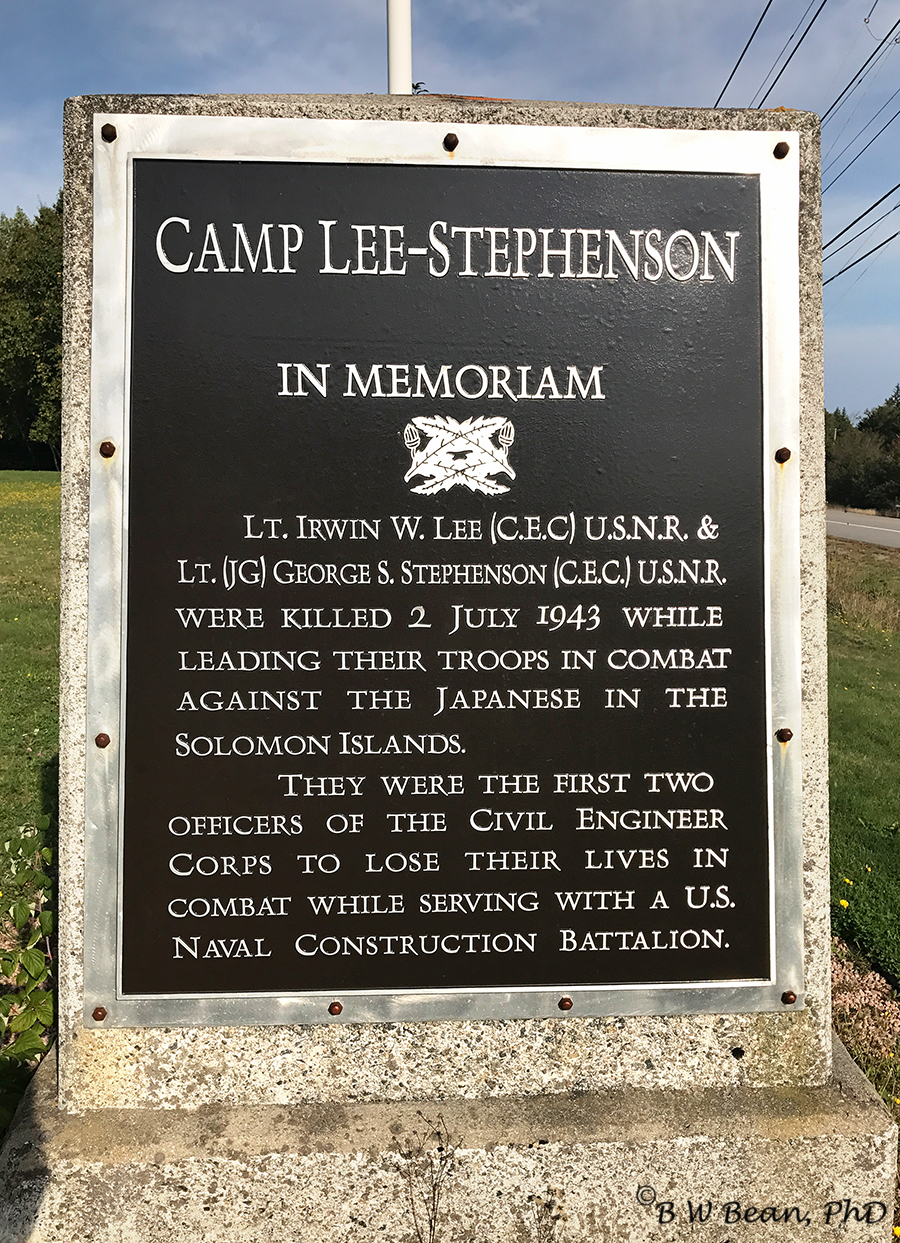
Eastport of course has not forgotten the Seabees. In September of 2005 a ceremony and rededication of the monument was held at Quoddy Village in Eastport. The streets of Quoddy Village are named after Seabees who served in Eastport. Kevin Raye spoke for the community when he said, “The Seabees are a part of the fabric of this community.”

